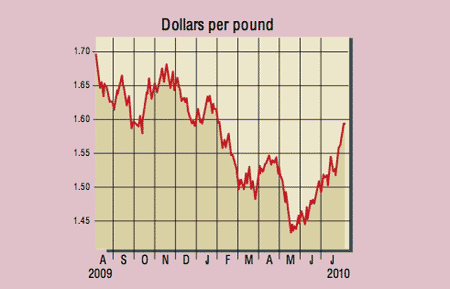
After sliding for most of the past two years, sterling is suddenly surging. It has gained almost 12% in two and a half months against the dollar, taking it to a six-month high around $1.60. On a trade-weighted basis – against a basket of major trading partners’ currencies – sterling has reached an 11-month high. But it is still 23% below its 2007 decade-high by this measure.
What the commentators said
The pound dipped after the election as investors feared that a fiscal crisis could be in the offing, said Ian Campbell on Breakingviews. But the coalition’s focus on “fiscal medicine, like a stern doctor’s prescription, has changed the international view of the UK’s health”.
Meanwhile, robust second-quarter GDP figures and bank earnings have also improved the overall economic picture. Investors have regained some appetite for risk and optimism about finance, so “finance-dependent” Britain benefits, said Lex in the FT. Britain’s relatively high inflation also implies higher interest rates than elsewhere in future.
But these days, “currencies are not so much stronger as less weak”, as Lex pointed out. A key part of the story here is how unappealing the dollar looks in comparison. Economic data have been disappointing. And there is talk of further easing by the Fed, possibly even further quantitative easing, to head off deflation. That means rates would be lower for longer.
So how much further can the pound go? The main problem is that the recovery is “rapidly losing momentum”, said Capital Economics. This week’s monthly survey of the services sector suggested that activity is down to its lowest level since June 2009. The manufacturing survey pointed to stalling export orders. Weak eurozone domestic demand and sterling’s bounce seem to have “brought the nascent export recovery to a halt”.
The fiscal squeeze has yet to kick in and house prices are set to fall further, discouraging consumption. In addition, bank lending remains “extremely weak”. So the second quarter is likely to be “as good as it gets” for growth for some time. Growth may reach 1.5% in 2010, but it will struggle to improve on this level in 2011. Given the darkening outlook, the pound may not look this (relatively) appealing for much longer. Campbell reckons it could reach $1.70 before “the sterling bears return for the autumn”.